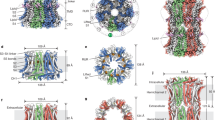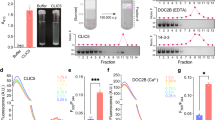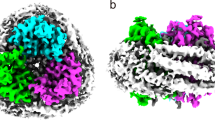Abstract
THE permeability of the membrane channels in Chironomus salivary gland cell junction depends on the cytoplasmic Ca2+ concentration ([Ca2+]i) (refs 1, 2). At the normal [Ca2+]i, < 10−7 M, the channels are highly permeable to a wide range of molecular sizes; the upper size limit for peptide molecules is about 1,200–1,900 molecular weight (MW) (refs 3,4). When the [Ca2+]i is elevated above 5×10−5 M in the junctional locale, the permeability falls drastically for all molecular species including the small inorganic ions2,5,6. With elevations ranging up to about 5×10−5 M the channel permeability is reduced for the 330-MW fluorescein molecule with little or no detectable reduction of electrical coupling7. This suggested the interesting possibility that in this range the permeability change may be selective, that is, the permeability may fall for the larger molecular species but not for the small inorganic molecules carrying the electrical current. An alternative—that a fraction of the junctional channels closed unselectively (that is, completely)—could not be excluded, however, because the sensitivities of the methods for discriminating changes in the junctional permeabilities of the large and small molecular species were not equivalent; the measurements of electrical coupling, while quite sensitive to changes in junctional permeability in the low range of electrical coupling, are relatively insensitive at high levels of coupling7. Here we investigate this point by testing junctional permeability with fluorescent molecules of various sizes. In each test we use a pair of molecular species and compare their transit times during simultaneous diffusion in the same direction across the junction. If and only if the non-selective mechanism governs the Ca2+-mediated permeability reduction, the transit for both species should be equally retarded, irrespective of size or structural differences between the probe molecules. We show that, at low [Ca2+]i elevation, the junctional permeability reduction is indeed selective and that the molecular size limit for junctional channel permeation changes in a graded manner.
This is a preview of subscription content, access via your institution
Access options
Subscribe to this journal
Receive 51 print issues and online access
$199.00 per year
only $3.90 per issue
Buy this article
- Purchase on Springer Link
- Instant access to full article PDF
Prices may be subject to local taxes which are calculated during checkout
Similar content being viewed by others
References
Rose, B. & Loewenstein, W. R. Nature 254, 250–252 (1975).
Rose, B. & Loewenstein, W. R. J. Membrane Biol. 28, 87–119 (1976).
Simpson, I., Rose, B. & Loewenstein, W. R. Science 195, 294–296 (1977).
Loewenstein, W. R. Cold Spring Harb. Symp. quant. Biol. 40, 49–63 (1975).
Loewenstein, W. R., Nakas, M. & Socolar, S. J. J. gen. Physiol. 50, 1865–1891 (1967).
Oliveira-Castro, G. M. & Loewenstein, W. R. J. Membrane Biol. 5, 51–77 (1971).
Délèze, J. & Loewenstein, W. R. J. Membrane Biol. 28, 71–86 (1976).
Rose, B. & Loewenstein, W. R. Science 190, 1204–1206 (1975).
Loewenstein, W. R. Ann. N. Y. Acad. Sci. 137, 441–472 (1966).
Goodenough, D. Cold Spring Harb. Symp. quant. Biol. 40, 37–43 (1975).
Gilula, N. B. & Epstein, M. L. Symp. Soc. exp. Biol. 30, 257–272 (1976).
Oschman, J. L. & Wall, B. J. J. Cell Biol. 55, 58–71 (1972).
Oschman, J. L. & Wall, B. J. in Transport Mechanisms in Epithelia (eds Ussing, H. H. & Thorn, N. A.), 392–402 (Munsgaard, Copenhagen, 1974).
Larsen, W. J. Cell Biol. 67, 801–813 (1975).
Peracchia, C. & Dulhunty, A. F. J. Cell Biol. 70, 419–439 (1976).
Loewenstein, W. R. Devl Biol. 19 Supl. 2 151–183 (1968).
Slack, C. & Palmer, J. F. Exp Cell Res. 55, 416–419 (1969).
Tupper, J. & Saunders, J. W. Devl Biol. 27, 546–554 (1972).
Bennett, M. V. L., Pappas, G. D. & Spira, M. E. Devl Biol. 29, 419–435 (1972).
Author information
Authors and Affiliations
Rights and permissions
About this article
Cite this article
ROSE, B., SIMPSON, I. & LOEWENSTEIN, W. Calcium ion produces graded changes in permeability of membrane channels in cell junction. Nature 267, 625–627 (1977). https://doi.org/10.1038/267625a0
Received:
Accepted:
Issue Date:
DOI: https://doi.org/10.1038/267625a0
This article is cited by
-
The diverse functional roles and regulation of neuronal gap junctions in the retina
Nature Reviews Neuroscience (2009)
-
Antibody perturbation analysis of gap-junction permeability in rat cardiac myocytes
Pfl�gers Archiv European Journal of Physiology (1993)
-
Membrane and junctional properties of the isolated frog lens epithelium
The Journal of Membrane Biology (1988)
Comments
By submitting a comment you agree to abide by our Terms and Community Guidelines. If you find something abusive or that does not comply with our terms or guidelines please flag it as inappropriate.



